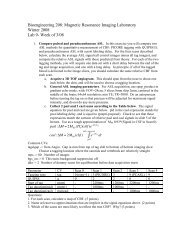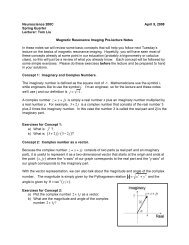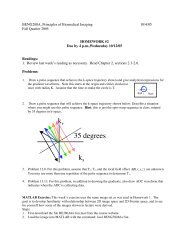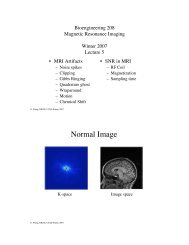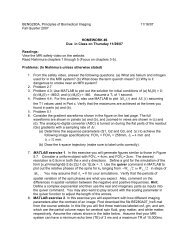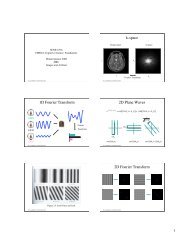Bloch Equation - Center for Functional MRI
Bloch Equation - Center for Functional MRI
Bloch Equation - Center for Functional MRI
You also want an ePaper? Increase the reach of your titles
YUMPU automatically turns print PDFs into web optimized ePapers that Google loves.
Phase with time-varying gradientk x =0; k y =0k x =0; k y ≠0TT Liu, BE280A, UCSD Fall 2008Fig 3.12 from NishimuraTT Liu, BE280A, UCSD Fall 2008G x (t)K-space trajectoryG y (t)k ytt 1 t 2!k y(t 4)k y(t 3)kt 3 t x4 k x(t! 1) k x(t 2)!!TT Liu, BE280A, UCSD Fall 2008TT Liu, BE280A, UCSD Fall 2008 Nishimura 19966
G x (t)K-space trajectoryG x (t)Spin-WarpG y (t)k ytt 1 t 2G y (t)t 1k yk xTT Liu, BE280A, UCSD Fall 2008k xTT Liu, BE280A, UCSD Fall 2008k-spaceImage spacek-spaceyk yxFourier Trans<strong>for</strong>mk xTT Liu, BE280A, UCSD Fall 2008TT Liu, BE280A, UCSD Fall 20087
!Static Gradient FieldsIn a uni<strong>for</strong>m magnetic field, the transverse magnetizationis given by:M(t) = M(0)e " j# 0t e "t /T 2In the presence of non time-varying gradients we haveM( r ) = M( ,0)e " j#B z ( r= M( ,0)e " j# ( B 0+ G r$ r= M( r ,0)e " j% 0 t e " j# rr )t e " t /T 2 ( r )r )t e " t /T 2 ( r )G $ r t e " t /T 2 ( r )Time-Varying Gradient FieldsIn the presence of time-varying gradients the frequencyas a function of space and time is:!( ) = #B z( r" r ,tr ,t)= #B 0+ # G r(t) $ r= " 0+ %"( r ,t)!TT Liu, BE280A, UCSD Fall 2008TT Liu, BE280A, UCSD Fall 2008PhasePhase = angle of the magnetization phasorFrequency = rate of change of angle (e.g. radians/sec)Phase = time integral of frequencyt( ) = # $( r" r ,t& r ,%) d%0= #$ 0t + '" r ,t( )Phase with constant gradientWhere the incremental phase due to the gradients is!t( ) = $ ' "%( r0t= $ ' ( G v( r"# r ,t0r ,& ) d&r ,& ) ) rd&!t( ) = $ ' "%( r1"# r ,t 10r ,&)"# r t( ,t 3 ) = $ ' "%( r30t( ) = $ ' "%( r2d&"# r ,t 2r ,&) d&0= $"%( r )t 2!if "% is non - time varying.r ,&) d&!TT Liu, BE280A, UCSD Fall 2008TT Liu, BE280A, UCSD Fall 2008!9
Time-Varying Gradient FieldsSignal <strong>Equation</strong>!The transverse magnetization is then given byM( r ,t) = M( r ,0)e "t /T 2 ( r ) e #(r r ,t )= M( r ,0)e "t /T 2 ( r ) e " j$ 0 t exp " j= M( r ,0)e "t /T 2( rr ) e " j$ 0t exp " j(t( ' %$( r ,t)d&o )t r( ' G (&) ) r d&o )!Signal from a volumes r(t) = " M( r ,t) dV= M(x, y,z,0)e #t /T 2 ( r ) e # j$ 0 t t r" exp # j% " G (&) ' r d& dxdydzV" "x y z( o )For now, consider signal from a slice along z and dropthe T 2 term. Definez 0 +$z / 2To obtain''x ym(x, y) " % M( r ,t) dzz 0 #$z / 2s r(t) = ! m(x, y)e " j# 0t exp " j$( 'o )t rG (%) & r d% dxdyTT Liu, BE280A, UCSD Fall 2008!TT Liu, BE280A, UCSD Fall 2008Signal <strong>Equation</strong>Demodulate the signal to obtainMR signal is Fourier Trans<strong>for</strong>ms(t) = e j" 0 t s r(t)''x y= m(x, y)exp # j$'' y(t r' G (%) & r d%o ) dxdy(t')= m(x, y)exp # j$o[ G x(%)x + G y(%)y]d%dxdyx''x y( ( ))= m(x, y)exp # j2( k x(t)x + k y(t)ydxdys(t) = $ m(x, y)exp " j2# k x(t)x + k y(t)y dxdy$x y( )= M k x(t),k y(t)[ ]kx (t ),k y (t )= F m(x, y)( ( ))!Wherek x(t) = "2#k y(t) = "2#%%t0t0G x($)d$G y($)d$!TT Liu, BE280A, UCSD Fall 2008TT Liu, BE280A, UCSD Fall 2008!10
G x (t) = 1 Gauss/cmExamplett 2 = 0.235msk y!k xk x(t 1) k x(t 2)k x(t 2) = " t% G x($ )d$2#0! = 4257Hz /G &1G /cm &0.235 '10 (3 s=1 cm (11 cmTT Liu, BE280A, UCSD Fall 2008!12






